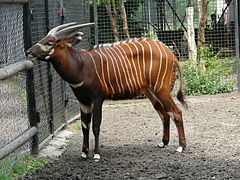Niala
| Tragelaphus[1] | |||
| Blainville, 1816[2] | |||
 Przedstawiciel rodzaju – samiec bongo leśnego (Tragelaphus eurycerus) | |||
| Systematyka | |||
| Domena | |||
|---|---|---|---|
| Królestwo | |||
| Gromada | |||
| Podgromada | |||
| Infragromada | |||
| Rząd | |||
| Podrząd | |||
| Infrarząd | |||
| Rodzina | |||
| Podrodzina | |||
| Plemię | |||
| Rodzaj | niala | ||
| Typ nomenklatoryczny | |||
Antilope sylvatica Sparrman, 1780 | |||
| Synonimy | |||
| |||
| Gatunki | |||
| |||
Niala[8] (Tragelaphus) – rodzaj ssaka z podrodziny bawołów (Bovinae) w obrębie rodziny wołowatych (Bovidae).
Zasięg występowania
Rodzaj obejmuje gatunki występujące w Afryce[9][10][11].
Morfologia
Długość ciała 114–235 cm, długość ogona 19–65 cm, wysokość w kłębie 61–135 cm; długość rogów 23–119 cm; masa ciała samic 24–253 kg, samców 32–405 kg[10].
Systematyka
Etymologia
- Tragelaphus: gr. τραγελαφος tragelaphos „kozło-jeleń”, od τραγος tragos „kozioł”; ελαφος elaphos „jeleń”[12].
- Euryceros: gr. ευρυκερως eurukerōs „z rozłożystymi rogami”, od ευ eu „dobry”; κερας keras, κερατος keratos „róg”[13]. Gatunek typowy: Antilope eurycerus Ogilby, 1837; młodszy homonim Euryceros Lesson 1831 (Aves).
- Hydrotragus: gr. ὑδρο- hudro- „wodny-”, od ὑδωρ hudōr, ὑδατος hudatos „woda”; τραγος tragos „kozioł”[14]. Gatunek typowy: Tragelaphus spekii Speke, 1863; młodszy homonim Hydrotragus Fitzinger, 1866 (Bovidae).
- Limnotragus: gr. λιμνη limnē „bagno”; τραγος tragos „kozioł”[15]. Nowa nazwa dla Hydrotragus J.E. Gray, 1872.
- Boocercus (Boocerus): gr. βους bous, βοος boos „byk, wół”; κερκος kerkos „ogon”[16]. Nowa nazwa dla Euryceros J.E. Gray, 1850.
Podział systematyczny
Do rodzaju należą następujące występujące współcześnie gatunki[9][8]:
- Tragelaphus scriptus (Pallas, 1766) – buszbok subsaharyjski
- Tragelaphus phaleratus (C.H. Smith, 1827)
- Tragelaphus bor Heuglin, 1877
- Tragelaphus decula (Rüppell, 1835)
- Tragelaphus meneliki Neumann, 1902
- Tragelaphus fasciatus Pocock, 1900
- Tragelaphus ornatus Pocock, 1900
- Tragelaphus sylvaticus (Sparrman, 1780)
- Tragelaphus spekii Speke, 1863 – sitatunga sawannowa
- Tragelaphus sylvestris (Meinertzhagen, 1916)
- Tragelaphus larkenii (St. Leger, 1931)
- Tragelaphus gratus P.L. Sclater, 1880
- Tragelaphus selousi Rothschild, 1898
- Tragelaphus eurycerus (Ogilby, 1837) – bongo leśne
- Tragelaphus buxtoni (Lydekker, 1910) – niala górska
Opisano również gatunki wymarłe:
- miocen
- Tragelaphus moroitu Haile-Selassie, Vrba & Bibi, 2009[17]
- pliocen
- pliocen–plejstocen
- Tragelaphus rastafari Bibi, 2011[24]
- plejstocen
Uwagi
- ↑ Niepoprawna późniejsza pisownia Boocercus O. Thomas, 1902,
Przypisy
- ↑ Tragelaphus, [w:] Integrated Taxonomic Information System [online] (ang.).
- ↑ H.M.D. de Blainville. Sur plusieurs espèces d’animaux mammifères, de l’ordre des ruminans. „Bulletin de la Société philomathique de Paris”. Année 1816, s. 75, 1816. (fr.).
- ↑ J.E. Gray: Gleanings from the menagerie and aviary at Knowsley Hall. Cz. 2. Knowsley: Printed for private distribution, 1850, s. 27. (ang.).
- ↑ J.E. Gray: Catalogue of ruminant Mammalia (Pecora, Linnaeus) in the British Museum. London: British Museum, 1872, s. 49. (ang.).
- ↑ P.L. Sclater & O. Thomas: The book of antelopes. Cz. 4. London: R.H. Porter, 1899–1900, s. 149.
- ↑ O. Thomas. On the East-African representative of the Bongo and its generic position. „The Annals and Magazine of Natural History”. Seventh series. 10, s. 309, 1902. (ang.).
- ↑ É.L. Trouessart: Catalogus mammalium tam viventium quam fossilium. Cz. 3: Quinquennale supplementum anno 1904. Berolini: Friedländer, 1904, s. 731. (łac.).
- ↑ a b Nazwy zwyczajowe za: W. Cichocki, A. Ważna, J. Cichocki, E. Rajska-Jurgiel, A. Jasiński & W. Bogdanowicz: Polskie nazewnictwo ssaków świata. Warszawa: Muzeum i Instytut Zoologii PAN, 2015, s. 181. ISBN 978-83-88147-15-9. (pol. • ang.).
- ↑ a b C.J. Burgin, D.E. Wilson, R.A. Mittermeier, A.B. Rylands, T.E. Lacher & W. Sechrest: Illustrated Checklist of the Mammals of the World. Cz. 2: Eulipotyphla to Carnivora. Barcelona: Lynx Edicions, 2020, s. 328–330. ISBN 978-84-16728-35-0. (ang.).
- ↑ a b C. Groves, D. Leslie, B. Huffman, R. Valdez, K. Habibi, P. Weinberg, J. Burton, P. Jarman & W. Robichaud: Family Bovidae (Hollow-horned Ruminants). W: D.E. Wilson & R.A. Mittermeier (redaktorzy): Handbook of the Mammals of the World. Cz. 2: Hoofed Mammals. Barcelona: Lynx Edicions, 2011, s. 597–610. ISBN 978-84-96553-77-4. (ang.).
- ↑ D.E. Wilson & D.M. Reeder (redaktorzy): Genus Tragelaphus. [w:] Mammal Species of the World. A Taxonomic and Geographic Reference (Wyd. 3) [on-line]. Johns Hopkins University Press, 2005. [dostęp 2021-04-23]. (ang.).
- ↑ Palmer 1904 ↓, s. 684.
- ↑ Palmer 1904 ↓, s. 280.
- ↑ Palmer 1904 ↓, s. 366.
- ↑ Palmer 1904 ↓, s. 377.
- ↑ Palmer 1904 ↓, s. 139.
- ↑ Y. Haile-Selassie, E.S. Vrba & F. Bibi: Bovidae. W: Y. Haile-Selassie & Giday WoldeGabriel (redaktorzy): Ardipithecus kadabbaLate Miocene Evidence from the Middle Awash, Ethiopia. Berkeley (California): University of California Press, 2009, s. 296. ISBN 978-0-520-25440-4. (ang.).
- ↑ P. Thomas. Recherches stratigraphiques et paléontologiques sur quelques formations d’eau douce de l’Algérie. „Mémoires de la Société Géologique de France”. Troisieme série. 3 (2), s. 16, 1884. (fr.).
- ↑ J.M. Harris: Family Bovidae. W: J.M. Harris (red.): Koobi fora research project. Cz. 3: The Fossil Ungulates: Geology, Fossil Artiodactyls, and Palaeoenvironments. Oxford: Clarendon Press, 1991, s. 145. ISBN 0-19-857399-5. (ang.).
- ↑ K.E. Reed & F. Bibi. Fossil Tragelaphini (Artiodactyla: Bovidae) from the Late Pliocene Hadar Formation, Afar Regional State, Ethiopia. „Journal of Mammalian Evolution”. 18 (1), s. 58, 2011. DOI: 10.1007/s10914-010-9146-6. (ang.).
- ↑ D. Geraads & H. Thomas: Bovidés du Plio-Pléistocène d’Ouganda. W: M. Pickford, B. Senut & D. Hadoto: Geology and Palaeobiology of the Albertine Rift Valley, Uganda-Zaire. Cz. 2: Palaeobiology. Orléans: CIFEG, 1994, s. 387, seria: Publications Occasionnelles Centre International pour la Formation et les Echanges Géologiques, nr 29. (fr.).
- ↑ L.H. Wells & H.B.S. Cooke. Fossil Bovidae from the Limeworks Quarry Makaspansgat, Potgietersrust. „Palaeontologia africana”. 4, s. 12, 1956. (ang.).
- ↑ D. Geraads, S. Melillo & Y. Haile-Selassie. Middle Pliocene Bovidae from Hominid-bearing sites in the Woranso-Mille area, Afar region, Ethiopia. „Palaeontologia africana”. 44, s. 59, 2009. (ang.).
- ↑ F. Bibi. Tragelaphus nakuae: evolutionary change, biochronology, and turnover in the African Plio-Pleistocene. „Zoological Journal of the Linnean Society”. 162 (3), s. 701, 2011. DOI: 10.1111/j.1096-3642.2010.00691.x. (ang.).
- ↑ D. Geraads. Bovidae et Giraffidae (Artiodactyla, Mammalia) du Pléistocène de Ternifine (Algérie). „Bulletin du Muséum national d’histoire naturelle”. 4e série, section C. 3 (1), s. 51, 1981. (fr.).
- ↑ C. Arambourg. Antilopes nouvelles du Pleistocene ancien de l’Omo (Abyssinie). „Bulletin du Muséum national d’histoire naturelle”. 2e série. 13 (4), s. 343, 1941. (fr.).
Bibliografia
- T.S. Palmer. Index Generum Mammalium: a List of the Genera and Families of Mammals. „North American Fauna”. 23, s. 1–984, 1904. (ang.).
Media użyte na tej stronie
Autor: (of code) -xfi-, Licencja: CC BY-SA 3.0
The Wikispecies logo created by Zephram Stark based on a concept design by Jeremykemp.

